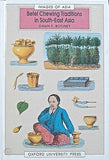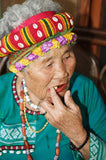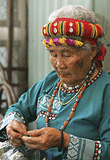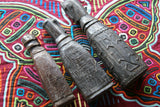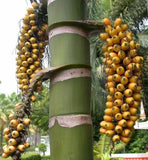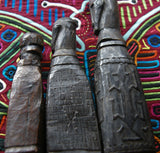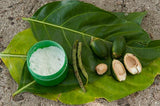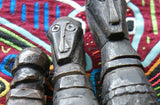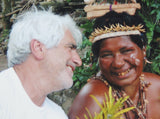3 CHOICES: Timor Ethnic Authentic Tribal Lime Containers ( used during Betel Habit chew), Vintage Hand Carved Receptacles with hand Carved Wood stoppers (with either ball or protective ancestor faces’ lids) BNW2A, BNW2B or BNW2C
Choice between 3 Rare Older Timor Shaman Hand carved wood Lime Containers, Paraphernalia of the betel nut habit chew. Some of them still have some white lime power coating the inside. Rich Patina. Once used by Shamans for magic powders, such as lime, in Timor
BNW2A: 5”
BNW2B: 6"
BNW2C: 7 1/2”
Entirely hand carved out of wood with traditional Timorese motifs, stylized geckoes for good luck and geometric figures hand etched or carved in relief within the wood. Two of the lids bear sculpted Ancestor faces which are meant to protect the owner of the container from evil spirits lurking in the woods.
The fruit of the areca palm (Areca catechu) is chewed together with lime and betel pepper as a stimulant by peoples of Asia, Africa and Papua New Guinea, among other places. Chewing it blackens the teeth and stains the mouth deep red.
Betel is one of the oldest intoxicants and was the most popular until the beginning of this century. Betel is classified as a mild stimulant similar to coffee. It has a multitude of meanings and uses, and the habit of chewing betel is well integrated into the different communities of the Golden Triangle as most of Asia .
Betel consists of three main ingredients. The leaf comes from a creeper called the betel plant. The second ingredient is a nut from areca palm, and the third is lime that is made from ground seashells or artificially manufactured. These ingredients form the betel quid that is chewed. In addition, other items such as tobacco, spices or medicinal plants may be added as desired.
In order to make a betel quid, you need a betel set. This consists of a number of containers for the different ingredients, a cutter or knife to cut up the areca nut and a mortar and pestle to mix the ingredients together. These elements are often carried in lacquer or metal boxes and can be very elaborately decorated.
Betel chewing causes a rapid production of saliva of a strong red color. After many years one’s teeth become black as a result. Red lips and black teeth were previously thought to be a sign of beauty, especially for young women. "Only dogs, ghosts and Europeans had white teeth!"
Betel played an important role in social interaction. A betel set was placed in front of a guest as a gesture of good manners. If the betel set was removed, it meant that the visit should be terminated. In courtship a gift of a betel quid was a sign of affection.
Betel was used extensively in rituals. In exorcism rituals betel was used as a means of transferring magical powers in order to drive out evil spirits. At marriage rituals, the couple was given a betel set for two symbolizing unity and fertility. In addition, the ancestral spirits received regular offerings of betel from the living.
Those who chew betel have always claimed that it has positive effects on the body. Western medicine has since verified this. Chewing betel protects teeth from bacteria and aids in digestion. The combination of ingredients in the betel quid actually kills a number of harmful stomach parasites.
Betel was very popular among all ethnic groups in Southeast Asia but is now only use by elderly women. Western ideals about appearances (white teeth) and hygiene (rules against spitting and the spread of diseases) have influenced local attitudes. The use of betel has decreased dramatically over the last 50 years and has been replaced by tobacco.
All our collector and rare items come with pages and pages of research about provenance, and with history of the tribes and photos as well, depending on item and whenever possible. When shipping internationally, we group ship multiple purchases to save you money. If you have any questions or want to see research conducted on this piece and photos of tribes, let us know.

















































